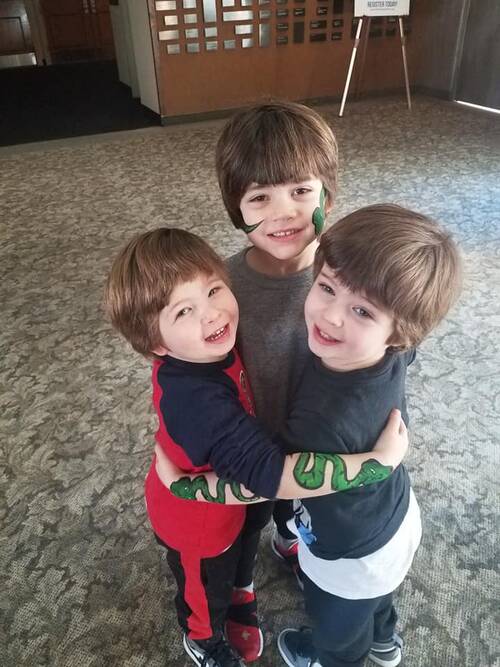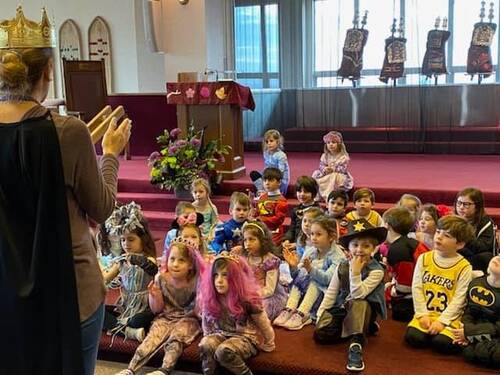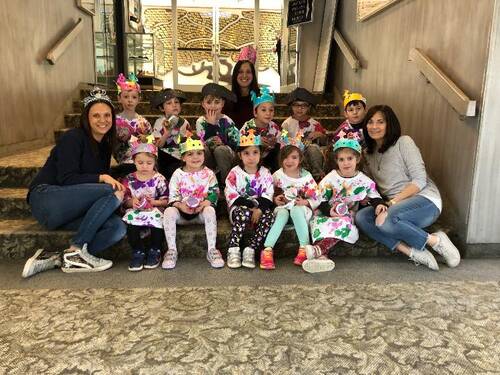Preschool at Temple Emanuel
Registration is now open! Click Here
Is this your child’s first time attending Jewish preschool (and your first child to attend Jewish preschool)? You may be eligible for a Jewish Right Start grant for up to $1,000 of tuition assistance as an incentive grant to choose Jewish preschool. Apply here.
Two's Program

Our two year old program puts a strong focus on the social/emotional development of young children. For many children, this is their first time transitioning into a school environment. Learning to trust other adults besides their primary caregivers, learning to be part of a classroom community, as they transition from parallel play to cooperative interactions, teaches empathy for their peers.
Motor planning – Working with manipulatives such as peg boards, geoboards and beads enhances the muscles in their fingers, allowing them to strength their dexterity for a proper pencil grip.
Cognitive – Children will be exposed to an environment of inquiry allowing for opportunities to explore concepts of pre-math skills such as counting, cause and effect, sorting, patterning, and problem solving. By the guided interest of the class as well as predisposed ideas and concepts, children will explore the natural world around them.
Language – Children develop their expressive language from the exposure to rich language in order to build their vocabulary and string words together to form sentences. They have the opportunity to practices these skills during group time. Reading books as well as literacy labels around the room expose children to pre-reading skills as well and showing letter symbols have meaning.
Three's Program

Our three year old program allows opportunities for children to gain their independence and the ability to manage and understand their own feelings and emotions as well as empathy towards others. Self-esteem is built as they become capable of completing tasks and having classroom responsibilities.
Motor planning – Coordination and balance continues to develop as children learn about spatial awareness. Children begin to manipulate smaller objects such as large buttons on their clothing and using scissors to make snips. Children hold a marker or crayon with thumb and two finger grip, making simple strokes.
Cognitive – Children at this age examine with attention to detail, noticing attributes of items as they sort by shape, color and size. This allows for the opportunity to create patterns. Three year olds show awareness of space, using positional words in, on under, over etc. They show basic math skills and an understanding of one-to-one correspondence as they count their peers.
Language – Children continue to enjoy and appreciate rhymes; three year olds will begin to create their own. They expand on their sentence development and follow multi-step directions. During story time, whether using picture or letters, children begin to understand that print carries a message. Children may begin to recognize and identify a few letters. This usually begins with the beginning letter of their own name and that of their peers.
Four's Program

Four year olds function with increasing independence in school. They are able to manage own feelings, calming down and explaining their emotions. Four year olds take reasonability and ownership over their classroom tasks, cleaning up after themselves understanding classroom expectations. Children at this age can enter play cooperatively, negotiating play with their peers.
Motor – Having control over their bodies is developed. Children this age can run quickly, change direction, ride toys with control and climb with ease. Four year olds throw objects with smooth overhand motion, and kick a ball with fluid motion. Children are learning to manipulate materials in a purposeful way, planning and attention to detail as they create tall structures that balance. They copy and draw simple shapes, letters and words including their names.
Cognitive – Four year olds observe attentively and are able to describe key features, recognizing differences in logos, models and sink and float experiments, testing out different ideas. They can find alternative solutions to problems for example; using a block as a door stop. Children this age can work on a Lego structure for a significant amount of time and continue working on it for 3-4 days. The concept of measuring is understood by using unit blocks to measure a rug or other objects around the room. Imitating complex patterns increase by imitating clapping patterns, or 3 color pattern using colored inch cubes. Time becomes more relevant and understood, “Tomorrow is Saturday, and we will not be in school.”
Language – Four year olds are able to answer questions with more detail. They can describe a family trip when asked about their weekend. They begin to ask increasingly more complex questions to further their own understanding. Children this age know each spoken word can be written down and read. A child will touch a written word for every spoken word in a story. They begin to make letter sound connections by writing a big M to represent “mommy”. They continue to make meaning out of written print through sounds, anticipating what comes next based on patterns and books with repetition.


